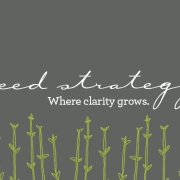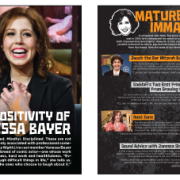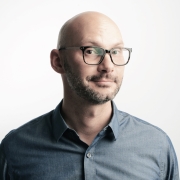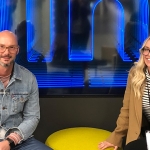Child’s Play: It Isn’t Just for Children
We spoke with Cincinnati’s resident kid expert about the power of play—and what that means for adults.
At some point in our lives, we forget what it means to play.
We forget that dolls and action figures can have lives of their own. We forget that Legos and Play-Doh can be anything we want… or nothing at all. Subconsciously, we embrace the notion that our doodles, drawings and musings must have purpose. And as we face the onslaught of obligations foisted upon us by adult life, we unwittingly trade the freedom to express, create and explore… for acceptance.
From our teachers. From our employers. From anyone who has the power to validate our place in the adult world—even ourselves.
“You don’t fail at play,” said Tony Lawson, Senior Director, School and Teacher Partnerships at the Cincinnati Museum Center. “You don’t pass play. It’s nothing you grade. So you have permission to be completely free. It may be successful, it may not be. But you’re free to try whatever you want to try.”
We recently spoke with Tony—a 20-year veteran of CMC’s critically acclaimed Children’s Museum—about what adults are missing without play in their lives.
Turns out, it’s more than just fun and games.
Zero Expectations. Infinite Possibilities.
“Play is something you enjoy. It’s fun, unstructured and doesn’t always have a goal,” Tony said. “You don’t have any idea, when you start play, what it could be. You don’t know where it could lead.”
Maybe it’s drawing.
Maybe it’s writing stories.
Maybe it’s photography.
Maybe it’s arts, crafts and scrapbooking.
According to Tony, it’s the lack of a definable goal that opens our minds and inspires our imaginations. When we’re playing, we’re free to explore. We’re free to see “what’s out there” in terms of new ideas and unique approaches. As we try new things and discover new experiences, we make new connections—both cognitively and creatively.
“It’s about experimentation. Being surprised. Setting aside your expectations. Play engages the right and left brain at the same time, so it creates a means for our creative side to feed into the logical side.”
Creativity workshops, innovation seminars, ideation exercises—they all strive to unlock the esoteric secrets of creativity. But in reality, play is our built-in creativity conduit. It’s how we all develop critical skills as children. And there’s no reason that can’t continue into adulthood. All we have to do is… let it happen. Without worrying about why it matters.
Or as Tony might say, you have to “invest in not having a goal.”
But what’s in it for me?
“We have so much to do,” Tony said, addressing the never-ending litany of responsibilities that typify adulthood. “Everything we do has to be useful.”
At some point in our lives, there’s a paradigm shift where we start to see everything we do as a means to some foreseeable end. It starts in school, it continues with our jobs. The world becomes a spectrum of cause and effect—where our actions must serve the interests of our personal aspirations and real-world obligations.
“Your goal is to learn this information, so you get an ‘A’ on this test, so you can move on to the next grade, so you can get a scholarship to college, so you can get a good job. It starts with the rigidity of school and continues into our adult lives.”
The idea that everything must have a definable purpose has been hammered into us for so long, it’s hard to go back. But the truth is, we still can. In fact, we should. Because, if we’re to realize our true potential as innovators, creators and ideators… we must.
Here’s why.
Play promotes creative problem solving.
As Tony pointed out, play helps stimulate right-brain/left-brain interaction. This helps us apply logical reasoning skills to complex challenges in creative ways. For instance, studies show that play improves our ability to solve divergent problems—in other words, problems that yield more than one possible solution.
“Kids given divergent play materials performed better on divergent problems. They also showed more creativity in their attempts to solve the problems.”[1] (Pepler and Ross 1981).
Obviously, children and adults play differently. But in the end, the effects are the same: voluntary activity that we enjoy opens cognitive pathways and promotes creative thinking.
Play improves memory.
“When you think about the workday,” Tony said, “it’s meeting, meeting, meeting… by the end of the day, do you have any idea what you talked about in that first meeting?”
Modern life moves fast—one thing to the next, with little downtime. But if we don’t give our brains a chance to catch up, our ability to retain information suffers.
“Our brains need time to just process information and encode it into long-term memory,” Tony explained. “Play actually helps us do that.”
The connection between play and memory is no secret. In fact, games—from crossword puzzles to the Legend of Zelda—are proven ways to exercise the mental muscles that influence memory.
Play stimulates emotional intelligence.
First and foremost, play is fun. In that, it provides an emotional escape—momentarily detaching us from the stresses of everyday life. It releases endorphins and promotes an overall sense of wellbeing.
“Through play, people get an emotional release,” Tony said. “Even just listening to music, or being in nature. We can consider things like these play, in essence.”
But play can also help us build empathy and understanding. When you use your imagination. When you let yourself indulge in fantasy and make-believe. It expands your world. It lets you see, feel and experience a different point of view—even if just in your mind.
But I’m a grownup. How do I… play?
That’s up to you.
Play can be anything that interests you, engages you and helps you feel good: writing, reading, drawing, acting, gaming, exercising, investigating local legends, building models, arts, crafts, role-playing, etc. But whatever it is… don’t do it because you think should.
Do it because you want to.
Forget about why it matters. Forget about the practical benefits listed above. Forget about what your spouse, your kids, your boss and your neighbors might think. Otherwise, you’ll hold back. You won’t fully immerse in the experience. You won’t give yourself the freedom to explore, discover and… grow.
And above all, make the time for it. Otherwise, it will never happen.
“Even though we’re not working toward a specific goal,” Tony assured us, “we shouldn’t view play as something that’s not productive. Play can certainly be productive for grownups too—but we have to find a way to show them that. We have to show them play is something that’s worthwhile and beneficial—and that’s something they have to trust us on.”
The Cincinnati Museum Center and the Duke Energy Children’s Museum is located in Union Terminal at 1301 Western Avenue, Cincinnati, OH 45203. For more information, visit http://www.cincymuseum.org.
Written by Matt Donahue. As a member of Seed’s copywriting team, Matt marries his love for creative writing with a keen interest in product innovation, technology and science. He’s a graduate of Seton Hill University’s “Popular Fiction” master’s program and writes whenever he can.
Connect with us! Follow Seed Strategy on our LinkedIn, Twitter, Facebook and Instagram pages.










